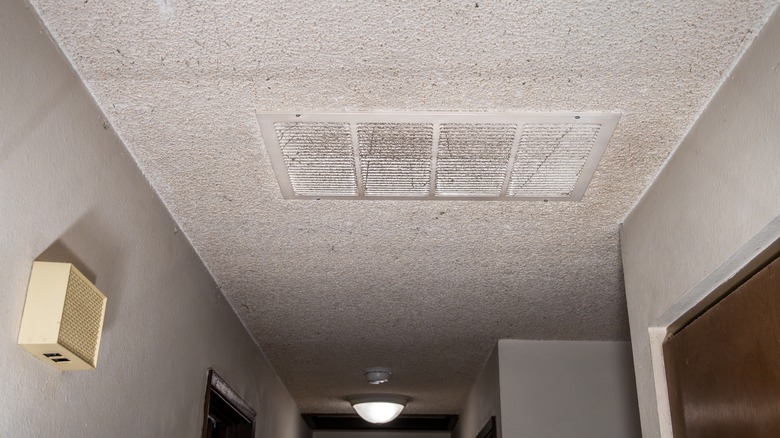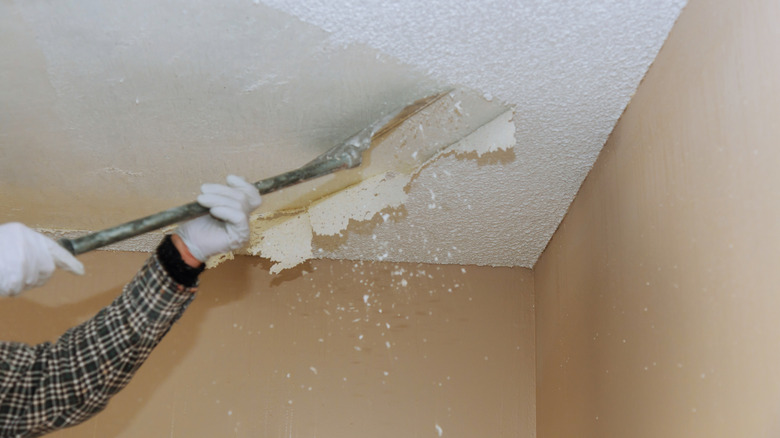The Long-Term Effects Of Popcorn Ceilings On Home Resale Value
When you're preparing to sell your house, updating the ceilings may be the last thing on your mind. Perhaps your real estate agent has suggested sprucing up the place with a new coat of paint. Maybe you're anxious that potential buyers will be turned off by your outdated granite countertops. Or worse, you're worried that no one will even schedule a viewing because you haven't done much to boost your home's curb appeal. It can be tricky to determine which projects you should tackle before putting your home on the market. But according to Rachel Stringer, a professional real estate agent at Raleigh Realty, removing your popcorn ceilings is one sure way to increase your resale value.
"As a general rule, I'd say that there really aren't any main benefits of keeping a popcorn ceiling if you're trying to sell your home," Stringer told House Digest during an exclusive interview. "With popcorn ceilings, it's important to remember that these were quite popular around the 1950s and 60s. Mainly, popcorn ceilings at the time were a cost-efficient way for homeowners to cover up any imperfections or flaws in a ceiling that they didn't want people to notice," she explained. Fast forward to 2025, and the general consensus is that popcorn ceilings look and feel outdated." The real estate agent said that in her experience, many homebuyers perceive popcorn ceilings negatively, which can have a detrimental impact on your resale value even when other features in your home are highly desirable.
Popcorn ceilings are problematic for several reasons
Why do people hate popcorn ceilings so much? When speaking exclusively with House Digest, Stringer explained that there are several different factors at play. "Some of the main reasons why people don't like them are due to the uneven texture, which looks out of place in 2025, as people prefer to opt for smooth ceilings," she said. Buyers may also prefer to see trendy ceiling designs like faux wood beams, decorative fretwork, or unique molding.
"Popcorn ceilings are also not a good option for anyone who wants to keep their home pristine and clean, as their surface builds up dust and dirt quite easily and negatively impacts the air quality in a property," the real estate expert added. Sure, you can use a long-handled vacuum attachment to clean dirt and dust off your popcorn ceilings, but your arms will likely be aching by the time you finish. If you miss a pocket of dust, potential buyers may spend more of their tour dreading the thought of this maintenance chore than envisioning how much they'll enjoy the spacious rooms.
There's a third reason popcorn ceilings can hurt your home's resale value, especially if it's an older home. "Many homes built before 1980 with popcorn ceilings may contain asbestos, which was commonly used to enhance durability and fire resistance," Stringer explained. The hazardous mineral fiber can cause serious health problems. If you're aware of asbestos being used in your popcorn ceilings, laws in your area may require you to disclose that fact to buyers.
Removing popcorn ceilings will increase your resale value
"By removing a popcorn ceiling, you can almost certainly increase your resale value," Rachel Stringer told House Digest during her exclusive interview. "The cost will naturally depend on factors such as the size of the ceiling and whether it contains asbestos. Just to remove a popcorn ceiling, you'd be looking at an average cost of around $1 to $5 per square foot or $15 to $50 per hour for labor, but including retexturing and painting, the cost ranges from anywhere between $2 to $8 per square foot," she said.
Despite the implications for your seller's disclosure, which you should discuss with your listing agent, Stringer advised checking for asbestos prior to removal. "If asbestos is present, a professional removal service can add $5 to $20 per square foot," she said. You can expect an inspector to visually check your popcorn ceilings (and other surfaces) before sampling them for lab analysis to determine if asbestos is present.
According to Stringer, the process of testing for asbestos and removing your popcorn ceilings is well worth it. "In terms of an ROI, and again, this is depending on various factors including the size of your home, the housing market, and whether asbestos is present, removing popcorn ceilings can have a very positive ROI, potentially around 70-80%," the real estate expert said. Other industry experts agree with her. Zillow, Curbio, and Angi's List report that buyers strongly prefer move-in-ready homes. Fixer-uppers, like those older properties with popcorn ceilings that haven't been addressed, are selling for significantly less.


